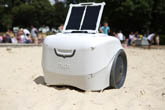 "For start-ups like us, I cannot overemphasize how important it is to quickly get to a stage where you can feasibly say whether your idea could be a viable product. Having access to 3D printing gives us the ability to make that decision faster than ever before," Luke Guttery, Product Design Lead at Nipi Smart Cooler
"For start-ups like us, I cannot overemphasize how important it is to quickly get to a stage where you can feasibly say whether your idea could be a viable product. Having access to 3D printing gives us the ability to make that decision faster than ever before," Luke Guttery, Product Design Lead at Nipi Smart Cooler
Stratasys multi-material 3D printing and UV-resistant ASA material key to rapid development of a fully-functional Nipi prototype for testing in multiple outdoor environments
Stratasys Ltd. (Nasdaq:SSYS), a global leader of 3D printing and additive manufacturing solutions, today announced that UK start-up company, Nipi Smart Cooler, has created a one-of-a-kind 'smart' cooler using Stratasys 3D printing. Employed throughout product development, Stratasys' technology has enabled Nipi to realize a functional prototype 75% faster than using traditional manufacturing methods. Aimed at the consumer market, the company has already surpassed its crowdfunding goal, and was recently backed by an Asian investor in order to accelerate the product to market.
Competing to be the world's most diverse, multi-purpose cooler, Nipi is a solar-panel-powered cooler offering ice retention of up to six days and is packed with a host of features including a charging hub, internal and external LED lighting, a safe deposit, cup holders and chopping board. According to Luke Guttery, Product Design Lead at Nipi Smart Cooler, 3D printing was crucial in quickly converting Nipi from a concept into a working product.
 "It's amazing how quickly we could go from an idea on a piece of paper to a fully-functional prototype that we could test outdoors," he says. "Without 3D printing, this simply would not have been achievable in the given timeframe. In just a few days we had already produced the main body in UV resistant materials to test the solar panels in the sun, and large-scale over-molded wheels with rigid interiors and rubber treads. Using this technology, we were able to develop a final working prototype in a just under a week, whereas with traditional manufacturing it would be closer to a month.
"It's amazing how quickly we could go from an idea on a piece of paper to a fully-functional prototype that we could test outdoors," he says. "Without 3D printing, this simply would not have been achievable in the given timeframe. In just a few days we had already produced the main body in UV resistant materials to test the solar panels in the sun, and large-scale over-molded wheels with rigid interiors and rubber treads. Using this technology, we were able to develop a final working prototype in a just under a week, whereas with traditional manufacturing it would be closer to a month.
"For start-ups like us, I cannot overemphasize how important it is to quickly get to a stage where you can feasibly say whether your idea could be a viable product. Having access to this technology gives us the ability to make that decision faster than ever before," adds Guttery.
Rapidly Transforming Nipi from a Concept to a Fully-Functional Prototype
In order to realize the initial concept designs as a 100% working prototype, Nipi turned to UK 3D printing service provider, 3D Print Bureau. Using both Stratasys' FDM and PolyJet 3D printing solutions, the company produced a number of fully-functional parts during the development of Nipi to eliminate problematic design issues, before committing to final manufacturing.
With outdoor enthusiasts its core target audience, prototyping the main body of the smart cooler required a material that could endure the continued exposure to sunlight. Using Stratasys' superior UV and heat resistant ASA thermoplastic material, 3D Print Bureau was able to produce a working prototype that could support the solar panel testing required in multiple outdoor environments. This enabled the Nipi team to make the design iterations required to ensure its fit-for-purpose for customers.
Stratasys multi-material 3D printing was used to produce over- molded parts, such as the handles and large tires that required accurate combinations of rigid and rubberlike materials. With the ability to 3D print these multi-material parts in a single build, as well as the capability to mix materials on-the-fly to create new material properties, 3D Print Bureau was able to quickly produce several variations in different levels of hardness for the Nipi team to test.
"Utilizing the best of each of Stratasys' 3D printing technologies was integral to getting a fully-functional, test-worthy prototype to the Nipi team," says Gary Miller, Managing Director of 3D Print Bureau. "With the ASA material, we were able to develop a fade-resistant prototype specifically designed for outdoor use. Using multi-material 3D printing, we could accurately validate the pull of the handle and its weight-bearing ability, as well as defining the exact tread of the tires required before moving to final production. In fact, the ability to over-mold using 3D printing was integral as it helped us determine the shape, thickness and style of the tread you see on Nipi today."
Andy Middleton, President of Stratasys EMEA, concludes: "For many start-ups with great ideas, limited capital to supplement costly and time-consuming traditional manufacturing is often the reason some innovations fail to reach the marketplace. 3D printing grants product designers the means to quickly and cost-effectively determine whether their idea can function and perform as intended, and Nipi is the perfect example."
www.stratasys.com




